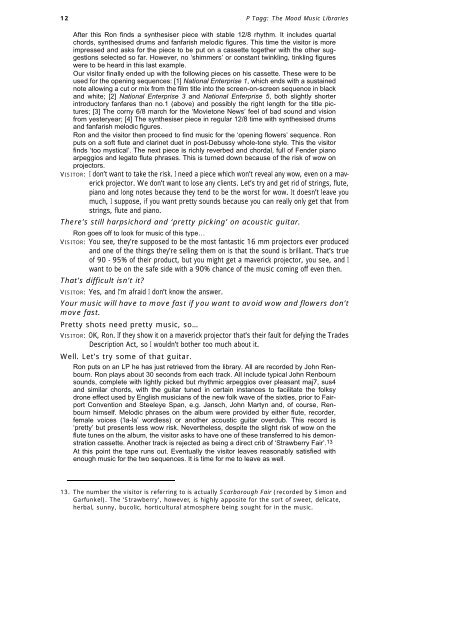interviews with library music producers - Philip Tagg
interviews with library music producers - Philip Tagg
interviews with library music producers - Philip Tagg
You also want an ePaper? Increase the reach of your titles
YUMPU automatically turns print PDFs into web optimized ePapers that Google loves.
12 P <strong>Tagg</strong>: The Mood Music Libraries<br />
After this Ron finds a synthesiser piece <strong>with</strong> stable 12/8 rhythm. It includes quartal<br />
chords, synthesised drums and fanfarish melodic figures. This time the visitor is more<br />
impressed and asks for the piece to be put on a cassette together <strong>with</strong> the other suggestions<br />
selected so far. However, no ‘shimmers’ or constant twinkling, tinkling figures<br />
were to be heard in this last example.<br />
Our visitor finally ended up <strong>with</strong> the following pieces on his cassette. These were to be<br />
used for the opening sequences: [1] National Enterprise 1, which ends <strong>with</strong> a sustained<br />
note allowing a cut or mix from the film title into the screen-on-screen sequence in black<br />
and white; [2] National Enterprise 3 and National Enterprise 5, both slightly shorter<br />
introductory fanfares than no.1 (above) and possibly the right length for the title pictures;<br />
[3] The corny 6/8 march for the ‘Movietone News’ feel of bad sound and vision<br />
from yesteryear; [4] The synthesiser piece in regular 12/8 time <strong>with</strong> synthesised drums<br />
and fanfarish melodic figures.<br />
Ron and the visitor then proceed to find <strong>music</strong> for the ‘opening flowers’ sequence. Ron<br />
puts on a soft flute and clarinet duet in post-Debussy whole-tone style. This the visitor<br />
finds ‘too mystical’. The next piece is richly reverbed and chordal, full of Fender piano<br />
arpeggios and legato flute phrases. This is turned down because of the risk of wow on<br />
projectors.<br />
VISITOR: I don’t want to take the risk. I need a piece which won’t reveal any wow, even on a maverick<br />
projector. We don’t want to lose any clients. Let’s try and get rid of strings, flute,<br />
piano and long notes because they tend to be the worst for wow. It doesn’t leave you<br />
much, I suppose, if you want pretty sounds because you can really only get that from<br />
strings, flute and piano.<br />
There’s still harpsichord and ‘pretty picking’ on acoustic guitar.<br />
Ron goes off to look for <strong>music</strong> of this type…<br />
VISITOR: You see, they’re supposed to be the most fantastic 16 mm projectors ever produced<br />
and one of the things they’re selling them on is that the sound is brilliant. That’s true<br />
of 90 - 95% of their product, but you might get a maverick projector, you see, and I<br />
want to be on the safe side <strong>with</strong> a 90% chance of the <strong>music</strong> coming off even then.<br />
That’s difficult isn’t it?<br />
VISITOR: Yes, and I’m afraid I don’t know the answer.<br />
Your <strong>music</strong> will have to move fast if you want to avoid wow and flowers don’t<br />
move fast.<br />
Pretty shots need pretty <strong>music</strong>, so…<br />
VISITOR: OK, Ron. If they show it on a maverick projector that’s their fault for defying the Trades<br />
Description Act, so I wouldn’t bother too much about it.<br />
Well. Let’s try some of that guitar.<br />
Ron puts on an LP he has just retrieved from the <strong>library</strong>. All are recorded by John Renbourn.<br />
Ron plays about 30 seconds from each track. All include typical John Renbourn<br />
sounds, complete <strong>with</strong> lightly picked but rhythmic arpeggios over pleasant maj7, sus4<br />
and similar chords, <strong>with</strong> the guitar tuned in certain instances to facilitate the folksy<br />
drone effect used by English <strong>music</strong>ians of the new folk wave of the sixties, prior to Fairport<br />
Convention and Steeleye Span, e.g. Jansch, John Martyn and, of course, Renbourn<br />
himself. Melodic phrases on the album were provided by either flute, recorder,<br />
female voices (‘la-la’ wordless) or another acoustic guitar overdub. This record is<br />
‘pretty’ but presents less wow risk. Nevertheless, despite the slight risk of wow on the<br />
flute tunes on the album, the visitor asks to have one of these transferred to his demonstration<br />
cassette. Another track is rejected as being a direct crib of ‘Strawberry Fair’. 13<br />
At this point the tape runs out. Eventually the visitor leaves reasonably satisfied <strong>with</strong><br />
enough <strong>music</strong> for the two sequences. It is time for me to leave as well.<br />
13. The number the visitor is referring to is actually Scarborough Fair (recorded by Simon and<br />
Garfunkel). The ‘Strawberry’, however, is highly apposite for the sort of sweet, delicate,<br />
herbal, sunny, bucolic, horticultural atmosphere being sought for in the <strong>music</strong>.














